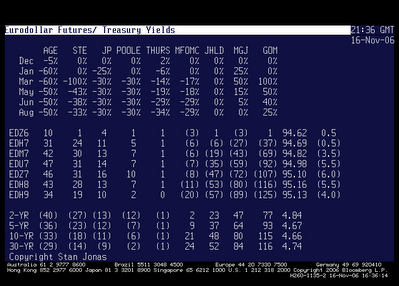The link I give is to the audio/visual of the talk, courtesy of Bloomberg. Hearing the two paragraphs reprinted below is much more powerful. The italics and bolding are mine.
"Over the next year or so, the economy appears likely to expand at a moderate rate, close to or modestly below the economy's long-run sustainable pace. Core inflation is expected to slow gradually from its recent level, reflecting the reduced impetus from high prices of energy and other commodities, contained inflation expectations, and perhaps further reductions in the rate of increase of shelter costs and some easing in the pressures on capital and labor resources. However, substantial uncertainties surround this baseline forecast. The Federal Open Market Committee (FOMC), the committee that sets monetary policy, will continue to monitor the incoming data closely. In its latest statement, the FOMC reiterated its view that the upside risks to inflation are the predominant risks to the forecast and indicated that it is prepared to take action to address inflation if developments warrant.
As I have just noted, the pace of economic activity has moderated over the course of the year. According to the latest estimates by the U.S. Department of Commerce, real gross domestic product (GDP) increased at an annual rate of 2.6 percent in the second quarter of 2006 and at a rate of only 1.6 percent in the third quarter. These figures are down noticeably from the 3-1/2 percent average pace of growth of the preceding two years. We will receive an updated estimate of third-quarter GDP growth tomorrow. At this juncture, information about economic activity in the fourth quarter is limited, and the range of plausible outcomes remains wide. But the indicators in hand suggest that real GDP growth this quarter is likely to be in the same general range that it was in the second and third quarters."
Here is how I heard it: Bernanke says the economy has moderated, inflation risks have gone down BUT "substantial uncertainies surround this baseline forecast". In our last statement we told you that inflation was the big risk. Now, as I was saying, the economy has moderated, growth is down substantially from where it was, and it looks like the current quarter will come in at the same pace as the previous two BUT current information is limited so "plausible outcomes remain wide".
One mention of inflation, lots about the slowdown, and a pointed reference to the uncertainty of the coming quarter. When you expect the quarter to come in at the low pace of the previous two, seems to me the uncertainty lies with greater weakness rather than strength.
The market, in its infinite wisdom is placing the odds of an ease in Jan at around 10%. Bernanke just told us its 50/50. If the market shifts to those odds, the Jan/Feb funds spread I wrote about yesterday makes 12 on a 2 tic investment (caveats everyone, no guarantees, it might not be for you, and this is only explanatory not a direct recommendation, etc, etc, etc).
All is possible as far as the economy is concerned. After all, if the Fed thought the economy was going to weaken further they would ease now not in January. They certainly wouldn't wait till March. By Jan 31 they will know Q4 and Jan sales, which have become quite important. There is nothing earth shattering to learn in the following 6 weeks that lead into the Mar meeting.
The December shift to a neutral bias is necessary for the ease. From then on, the decks are clear for the data to lead the Fed.





